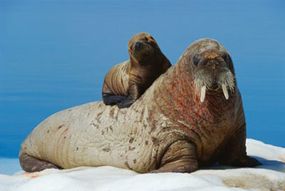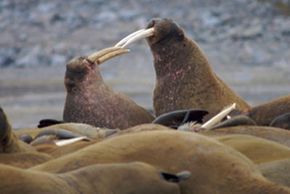Walrus Behavior and Reproduction
Walruses have few predators other than the occasional killer whale or brave polar bear. Thus they tend to live relatively long life spans of around 30 years. During their lifetimes, male and female walruses live apart, in separate herds. Females stay with the same herd throughout their lives, and males leave their birth herd after two to three years to join the male herd.
Female Pacific walruses migrate annually in herds. In summer when the ice melts and recedes, the females head north to the Chuckchi Sea. They return south to the Bering Sea before the ice freezes in the winter. Researchers aren't entirely sure why males don't migrate to the extent that females do, but some scientists speculate it may be related to sperm production. Little is known about the migration patterns of the Atlantic walrus; they seem to stay in the same general area year-round.
Advertisement
Male walruses usually reach sexual maturity at around age eight to 10. Females mature at five to six years old. Even though they are sexually mature, males do not usually mate until around age 15, and females don't begin mating until age 10.
Pacific walruses mate between December and March. The females meet the males to mate when they return from their migration north. Females only mate once every two years or more due to their long gestation period of 15 months. Thus, females who are still pregnant from the previous breeding season separate from the others when the mating ritual begins.
The remaining females congregate on the ice pack and prepare to be entertained by the males in the water. One or two males generally perform for each congregation of roughly 23 females -- presenting a series of vocalizations both above and below water. Here, the males' pharyngeal muscles (near the throat) come in handy both as flotation devices and as amplifiers. The males simply inflate the pouches to remain upright in the water and begin to serenade. Along with other noises, they clack their teeth, whistle and make bell sounds until a female is so impressed that she enters the water to mate. Males usually space themselves 23 feet and 33 feet (7-10 meters) apart or battle for the prime display spot. Dominance in the male herds is established by body size, tusk size and aggressiveness.
For the first four or five months of gestation, fertilized eggs float around in the female's uterus before implanting in the uterine wall and starting to develop. This delay in implantation is determined by metabolic conditions, and is thought to ensure that calves are born in the optimal environment. Females give birth between mid-April and mid-June, as they migrate north. They stay with their newborns until the following April just before their next birth. If they don't get pregnant with a new calf the following season, they may stay with their young for as long as two and a half years.

Cows are very protective of their young. They even go so far as to separate them from the other walruses to form nursery herds with other mothers. Cows nurse their calves for up to two years depending on whether they get pregnant again the following year. Cows often give their young rides on their backs even though calves can usually swim after just one month.
Walrus calves are certainly not tiny little bundles at birth. They weigh between 99 pounds and 165 pounds (45 kg-75 kg) when born and grow 4 to 6 inches (10-15 centimeters) a month, gaining 1.5 pounds to 2 pounds (0.7 kg-0.9 kg) a day. They tend to be darker than the adults in color, and they get lighter as they age.
Walruses seem harmless enough. So why have hunters killed so many walruses that their overall numbers have periodically dwindled? Learn more on the next page.
